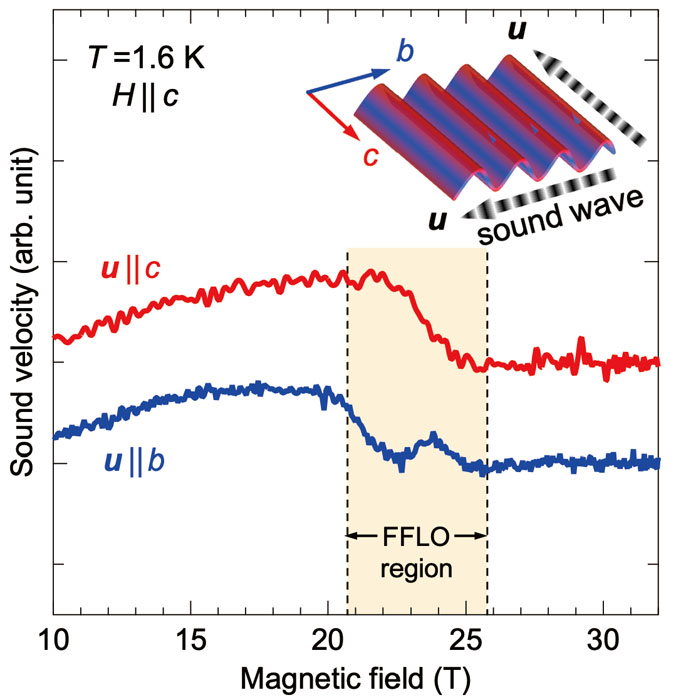Detection of the Spatial Modulation of the FFLO State in High Magnetic Fields
Kindo and Kohama Groups
Superconductivity appears as a result of forming pairs of itinerant electrons by an attractive force. In the case of conventional superconductivity, the electron pairs are composed of electrons with momenta k and −k. In 1964, Fulde & Ferrell [1] and Larkin & Ovchinnikov [2] proposed that an imbalanced pairing of up-/down-spin electrons with momenta k and −k+q, known as the FFLO state, can be realized in high fields where Zeeman splitting energy exceeds the superconducting energy gap. In the FFLO state, the finite total momentum of the pair q modifies the order parameter of the superconductivity and yields the term cos(qr), which results in spatial oscillations of the superconductivity in real space. Although the spatial modulation of the order parameter is one of the most decisive pieces of evidence of the FFLO state, it has never been experimentally observed.
In order to detect the spatial modulation, we carried out multi-directional ultrasound measurements of one of the FFLO candidates, an organic superconductor κ-(BEDT-TTF)2Cu(NCS)2, in pulsed magnetic fields [3]. Figure 1 shows the magnetic-field dependence of sound velocity at 1.6 K when polarization vectors of sound waves u are along the crystal axes parallel to the conducting plane, b and c. Magnetic fields are applied parallel to the c axis. From the results of previous studies of this material, the field where the Zeeman energy reaches the superconducting energy gap is expected to be about 21 T, and also, the superconductivity is completely suppressed above 25 T. Namely, the FFLO state can be stable in the field range of 21–25 T. Indeed, as clearly seen from our results, only in this field region, a distinct difference appears between the two datasets. It is natural because the spatial modulation produced by the q vector, as shown in the inset of Fig. 1, must make the superconducting state anisotropic. Since only the u||b data shows the enhancement of the sound velocity, the emergent superlattice of the spatial modulation should be parallel to the b axis. This means that q should orient along the b axis. In the case of κ-(BEDT-TTF)2Cu(NCS)2, it is expected that antiferromagnetic spin fluctuations along some nesting vectors mediate the pairing of the superconductivity, and one of the most predominant nesting direction points towards the b axis. It seems reasonable because an energy gain by better nesting stabilizes the FFLO state in a low-dimensional superconducting state. This agreement experimentally unveil the nature of the FFLO state occurred in the low-dimensional superconductivity.

Fig. 1. Anisotropic acoustic response in the FFLO state.Magnetic field dependence of sound velocity at 1.6 K for u||b (blue) and u||c (red) in a magnetic field along the c axis. Only in the FFLO region between 21–25 T, the sound-wave-direction-dependent response is observed. The schematics in the inset show the spatial modulation of the FFLO state composed of superconductivity (red) and normal state (blue). The striped arrows signify the sound-wave directions, which are parallel to the polarization vector u.
Nowadays the concept of the unique pairing of the FFLO state has been widely investigated in various physics not only condensed matter physics but also elemental particle physics and so on. The present results demonstrate that the spatial modulation of the FFLO state can be discussed by the emergent anisotropy of the acoustic properties. Our findings will facilitate a deeper understanding of the FFLO state.
References
- [1] P. Fulde and R. A. Ferrell, Phys. Rev. 35, A550 (1964).
- [2] A. I. Larkin and Y. N. Ovchinnikov, Zh. Eksp. Teor. Fiz. 47, 1136 (1964).
- [3] S. Imajo, T. Nomura, Y. Kohama, and K. Kindo, Nat. Commun. 13, 5590 (2022).
